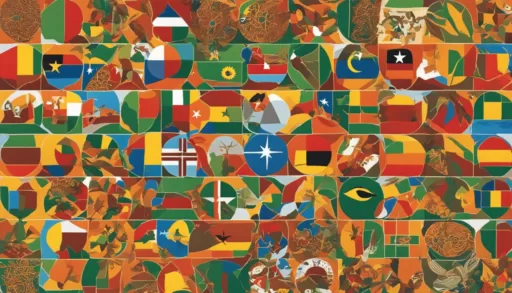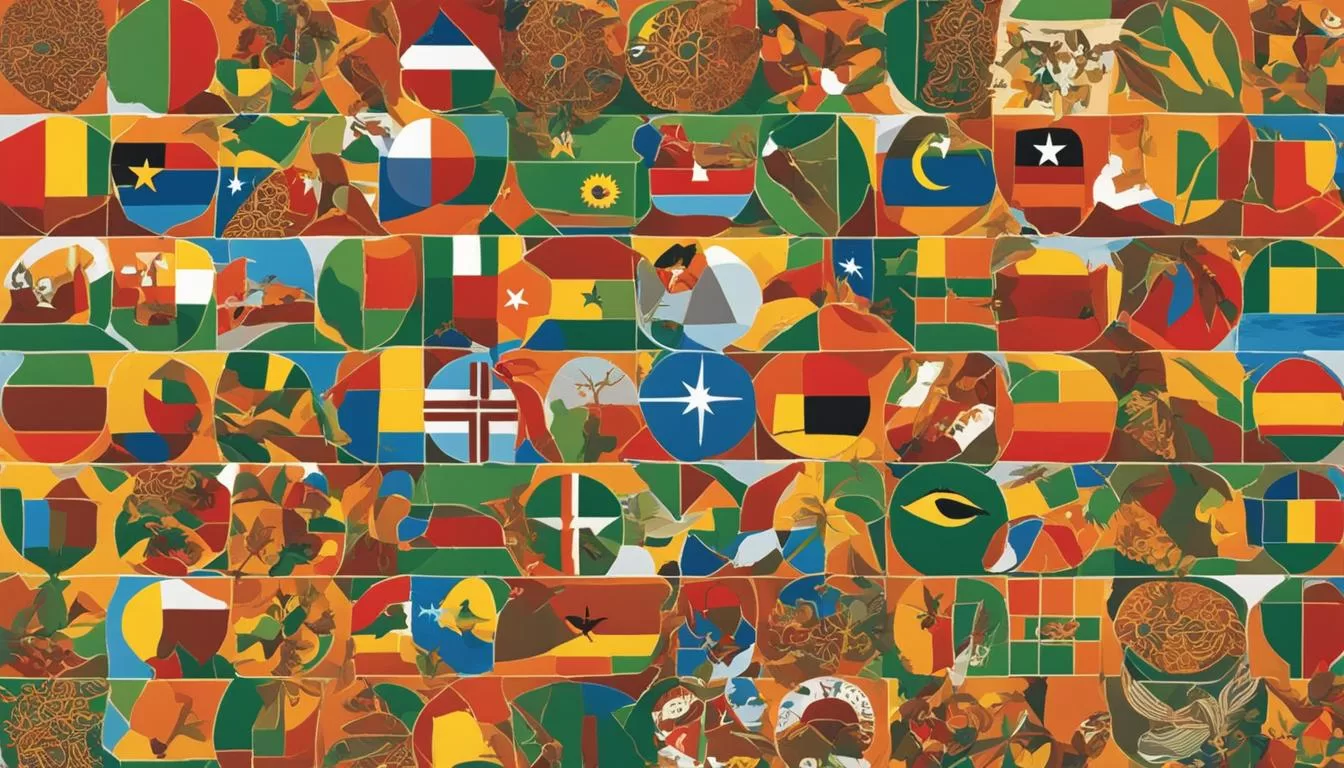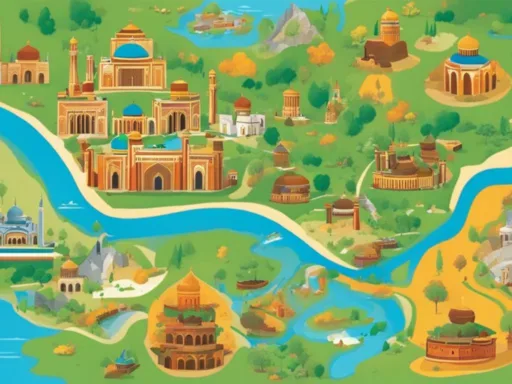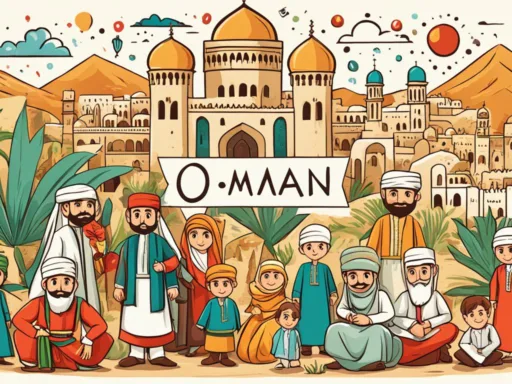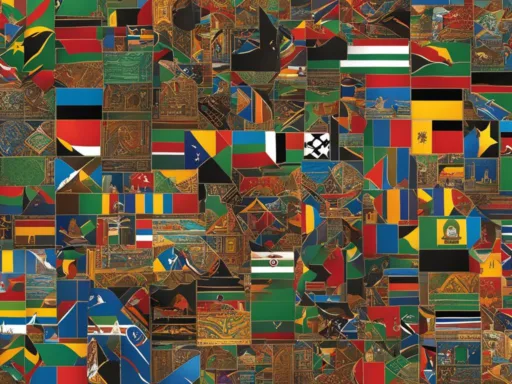Nestled on the West African coast, Guinea-Bissau stands as a testament to the vibrancy of cultural intermingling, which is brilliantly reflected in its linguistic landscape. The languages spoken in Guinea-Bissau encompass a compelling range of dialects, each narrating tales of the nation’s eclectic past. The official language of Guinea-Bissau is Portuguese, originating from the era of European exploration and colonial rule—a language whose usage is prevalent in officialdom yet is mastered by a minority. Meanwhile, the unsung hero of national communication is Guinea-Bissau Creole, often simply known as Kriol, an emblematic blend of Portuguese influence and local lexicons.
It’s the profound Guinea-Bissau linguistic diversity which characterizes daily interactions among its people, creating a rich social tapestry. Whether it’s the hum of Creole in the bustling markets, the formalities of Portuguese in institutions, or the symphony of indigenous tongues in rural expanses, each language adds depth to the country’s identity. This variety not only boasts the nation’s multifaceted heritage but also paves the way for a future where cultural fluency and inclusivity are forefront.
Key Takeaways
- Guinea-Bissau’s linguistic diversity is a fusion of colonial legacies and indigenous customs.
- Portuguese serves as the official language, though spoken fluently by a relatively small populace.
- Guinea-Bissau Creole, with expansive reach, stands as the nation’s lingua franca.
- The country’s indigenous languages, with varying degrees of prevalence, form the crux of its ethnic richness.
- Multilingual education featuring French and English strengthens the country’s global connections.
- Understanding the dynamics of the languages spoken in Guinea-Bissau is key to appreciating its cultural complexity.
The Linguistic Landscape of Guinea-Bissau
The imprints of the Portuguese influence in Guinea-Bissau resonate profoundly throughout the nation’s linguistic portfolio. Having been shaped by waves of history, the linguistic history of Guinea-Bissau is emblematic of its colonial past and the interplay between foreign and native elements. The tongues spoken here narrate stories of trade, governance, education, and everyday life, revealing a tapestry that is as diverse as the people themselves.

History and Influence of Colonial Languages
In corridors of power and formal instruction, Portuguese dominates as the official language of Guinea-Bissau. Its prevalence is underscored through voter education as seen in the legislative elections of 2008, where material was predominantly in Portuguese, signifying its authoritative role. Yet, for many Bissau-Guineans, Portuguese is often a second string to their linguistic bow, holding court mainly in urban areas like the capital.
Diversity of Indigenous Languages
In stark contrast, the indigenous languages of Guinea-Bissau flourish, spoken by nearly half the population. These languages—among them Fula, Balanta, Mandinka, and Papel—serve as the living heartbeat of Guinea-Bissau’s local cultural fabric. More than just methods of communication, these indigenous tongues are key to the social and cultural identities of their ethnic groups, and they resonate most in the rural heartlands. Here, languages act as conduits for heritage, creating an intimate channel for the transmission of culture and community bonding, thus preserving the linguistic diversity that defines this nation.
Languages Spoken in Guinea-Bissau
The official and popular languages of Guinea-Bissau reflect a nation rich in cultural and linguistic diversity. While Portuguese maintains its status as the official language, it is spoken by a relatively small percentage of the population. In the realm of daily communication, Guinea-Bissau Creole proudly serves as the common tongue, bridging linguistic gaps and unifying the nation’s people.

Portuguese, once rooted deeply in colonial times, now finds itself woven into the educational and administrative fabric of the country. Despite this, its reach is limited, and it is often in the shadows of the more accessible and pervasive Guinea-Bissau Creole.
Understanding the Official Language: Portuguese
Seen as a symbol of academia and governance, the official language of Guinea-Bissau, Portuguese, is central to the official matters of the state. This historical language conveys a sense of formality and remains the medium for legislation, administrative functions, and scholarly discourse. However, its usage amidst the general population is confined to a smaller proportion, grappling with challenges such as literacy and the rich cultural diversity that characterizes the nation.
Popularity and Usage of Guinea-Bissau Creole
In contrast to the formal echelons of Portuguese, Guinea-Bissau Creole stands tall as the true linguistic stalwart among popular languages in Guinea-Bissau. Its widespread usage paints a picture of linguistic unity, with an impressive 90.4% of the population employing it as a communicative tool as per the 2009 census. Guinea-Bissau Creole is notably predominant amongst the youth and the literate, an indication of its fluid nature and significance in shaping the country’s modern linguistic landscape, presenting an interesting alignment with the evolution of Portuguese.
- Official Language: Portuguese – Used in formal communication and education.
- Popular Language: Guinea-Bissau Creole – Spoken by the majority of the population.
- Portuguese – Spoken by a smaller segment of the population, primarily in official capacities.
- Creole – Embraced widely, especially by the younger and educated demographics.
These languages are not just tools for interaction but represent the living history and evolving identity of Guinea-Bissau. As one navigates through the bustling cities or peaceful countryside, the melodic sounds of Portuguese and the vibrant cadences of Guinea-Bissau Creole serve as echoes of the nation’s past and the pulse of its present.
The Role of Indigenous Languages in Guinea-Bissau
In the heart of West Africa, Guinea-Bissau’s tapestry of cultures is intricately woven with a plethora of indigenous tongues that play a crucial role in the nation’s sociolinguistic fabric. The preservation and promotion of indigenous language preservation are pivotal in maintaining the country’s cultural heritage. It is within the whispers of the Fula, the laughter in Balanta, and the wisdom in Mandinka that the true spirit of Guinea-Bissau is heard.

These national languages of Guinea-Bissau not only facilitate communication in their respective ethnic groups but also carry forward age-old traditions and knowledge. The rural heartlands, in particular, are bastions of minority languages Guinea-Bissau, where oral literature, proverbs, and folklore continue to thrive—ensuring these dialects remain vibrant and resilient in the face of globalization.
A true understanding of Guinea-Bissau’s cultural diversity can only be attained through an appreciation of its indigenous languages—which are as rich in history as the land itself.
Let’s take an insightful journey through some of these languages, their prevalence, and the vital connections they establish among the communities of Guinea-Bissau:
| Language | Speakers | Regional Prevalence | Cultural Significance |
|---|---|---|---|
| Fula | Approximately 16% | Rural and Urban Areas | Important for trade, history, and ethnic identity |
| Balanta | Around 14% | Mainly Rural, some Urban Presence | Critical for local customs and traditional rites |
| Mandinka | Nearly 7% | Rural Areas, especially in the North | Historical narratives, community leadership |
In the spirit of preservation, various efforts are in place to ensure that these languages continue to be spoken and taught to future generations. Whether it is through formal education or community-led initiatives, the drive for indigenous language preservation in Guinea-Bissau is emblematic of the country’s respect for its ancestral heritage and a recognition of the irreplaceable value these languages hold within society.
Note: The percentages provided are indicative of the languages’ reach within the population and hint at the linguistic mosaic that exists within the nation.
As we explore the dynamics of language in Guinea-Bissau, it becomes evident that indigenous languages are not merely a means of daily communication. They are the stronghold of the nation’s identity and continue to shape the lives of its people in profound and unquantifiable ways.
Guinea-Bissau Creole: A Bridge Between Cultures
The linguistic identity of Guinea-Bissau is marked by the pervasive influence of Guinea-Bissau Creole, also known as Kriol language—a unique tapestry that is deeply interwoven within the nation’s social fabric. It is the language that teems in the streets, homes, and hearts of the people, standing as a testament to their shared histories and diverse backgrounds. This Portuguese-based creole has emerged as an invaluable cultural bridge, fostering communication and understanding among the myriad of communities in Guinea-Bissau.

The story of Guinea-Bissau Creole is one of cultural synthesis and adaptation, where decreolization processes reflect its dynamic character. Younger generations, particularly those who are literate, are spearheading a linguistic evolution whereby Creole is aligning more closely with standard Portuguese—a phenomenon that is both intriguing and indicative of broader social trends. It is decreolization at work, molding the language to better fit the contours of a changing society.
Despite undergoing transformation, the essence of Guinea-Bissau Creole as a facilitator of unity remains steadfast. Its utility extends beyond mere conversation, serving as a vessel for the transmission of cultural nuances and the collective memory of a people. The gradual shift towards the lexicon and structures of Portuguese does not diminish Creole’s role; rather, it enriches its narrative, adding layers of complexity to its already multifaceted nature.
In the bustling streets of Bissau, the resonant sounds of Kriol encapsulate the spirit and resilience of its speakers, weaving a cohesive tapestry from the threads of a multicultural society.
| Aspect of Guinea-Bissau Creole | Impact on Society | Example |
|---|---|---|
| Cultural Integration | Creole serves as the medium for sharing traditions and merging customs. | Festivals incorporating Portuguese and African music styles. |
| Educational Influence | Enhances learning experiences by incorporating local contexts into education. | Bilingual textbooks featuring Creole narratives. |
| Linguistic Evolution | Reflects a society in transition, adapting to educational advancements and global influences. | Younger, literate speakers incorporating more Portuguese phrases into daily Kriol usage. |
As a bridge connecting communities, Guinea-Bissau Creole epitomizes the ingenuity and adaptability of language as a living entity—one that adjusts and grows with the social currents that shape it. The interlace of decreolization practices propels Creole forward as an enduring element of Guinea-Bissau’s cultural legacy, ensuring its relevance for generations to come. In its echoes, one can discern the forward march of a language that represents both a people and their persistent stride towards a unified cultural expression.
In the final analysis, the journey of Guinea-Bissau Creole—from its nascent forms to the present-day sociolinguistic milieu—is a testament to the unifying power of language and the multifaceted nature of human expression. It is this complexity that makes the study of Creole not just a linguistic endeavor but a passage into the depths of humanity’s collective experience.
Educational Impact on Language in Guinea-Bissau
Within the broad spectrum of Guinea-Bissau’s languages, the educational system plays a pivotal role in shaping the linguistic aptitude of its citizens. Transcending beyond the vernacular and the official tongue, the realm of academia incorporates additional foreign languages that contribute significantly to the nation’s global linguistic identity. The introduction of the French language in Guinea-Bissau and the rise of English influence in Guinea-Bissau within schools reflect a strategic move towards cultivating a multilingual generation capable of thriving in an interconnected world. Delving into the educational languages of Guinea-Bissau reveals an enriching backdrop of diversity and cultural exchange, unfurling a vast array of opportunities for communication and collaboration across borders.

While the educational sector is instrumental in the promotion of the native and official languages, the inclusion of foreign tongues such as French and English underscores the nation’s outlook towards embracing both regional affinities and global perspectives. By fostering proficiency in multiple languages, Guinea-Bissau positions its youth to engage confidently with neighboring countries and the broader international community, thereby reinforcing the nation’s presence on the world stage.
The Introduction of French in Schools
The strategic implementation of the French language in Guinea-Bissau’s educational curriculum is informed by the nation’s geographical context and diplomatic ties. Surrounded by Francophone countries, a competency in French equips Bissau-Guinean students with the linguistic tools necessary for seamless cross-border interactions and regional integration. As a full member of the Francophonie, Guinea-Bissau has embraced French as not only an asset for intercultural dialogue but also a conduit for economic, political, and social relations. This educational initiative is imbued with the foresight of fostering a populace that is versatile in communication and adaptive to various cultural landscapes.
English and Other Foreign Languages in the Curriculum
In parallel with French, the inclusion of English influence in Guinea-Bissau’s educational syllabi is a nod to the language’s global stature. While English may occupy a less pronounced role compared to French within the region, its presence in schools addresses the exigencies of international exchange and connectivity. As global trade and technology pivot largely around English-speaking hubs, acquiring linguistic proficiency in English presents itself as an indispensable skill for Bissau-Guineans seeking to navigate and contribute to the wider world. Promoting educational languages in Guinea-Bissau thus serves as a powerful testimony to the country’s commitment to building a well-rounded, internationally-competent citizenry.
In essence, the strategic integration of foreign languages into Guinea-Bissau’s education system marks a forward-thinking approach to language learning. This vision is endowing the nation’s future generations with a versatile linguistic repertoire that promises to bolster individual growth, foster international engagement, and reinforce cultural diplomacy on multiple fronts.
Regional Variation and Language Dynamics in Guinea-Bissau
The intricate network of regional languages in Guinea-Bissau is a vivid reflection of the country’s multifarious ethnic collective. This linguistic mosaic is not static; the ceaseless flow of cultural exchanges shapes a vibrant arena where language variation in Guinea-Bissau is the norm rather than an exception. Here, speech patterns mirror the very essence of locality – each regional dialect a looking glass into the lives and histories of its speakers. From the coastal whispers of the Bijagos islands to the animated marketplace banter in Bafatá, language dances to the rhythm of regional variance.
The cultural topography of Guinea-Bissau ensures that language dynamics in Guinea-Bissau are continuously under the forces of change and evolution. The adaptation of traditional dialects to incorporate new societal elements is an ongoing process – one that reflects an innate human ability to acclimatize linguistically to the currents of time. As globalization’s tendrils reach even remote villages, interactions prompt gentle shifts in vernacular that, at times, introduce entirely new linguistic elements into the local tapestry.
At the crossroads of conservation and innovation, the inhabitants of Guinea-Bissau face the challenge of preserving their rich heritage languages while welcoming beneficial aspects of foreign languages and creoles. This melange forms a dynamic crucible of communication, deeply entrenched in identity yet fluid enough to embrace progress and learning. It’s a cultural equilibrium, balancing the need for growth with the invaluable retention of a storied linguistic legacy, indicative of the resilience and vibrancy of the Bissau-Guinean spirit.
FAQ
What are the official languages spoken in Guinea-Bissau?
Portuguese is the official language of Guinea-Bissau, used for government, legal matters, and education. Guinea-Bissau Creole, also known as Kriol, although not officially designated, serves as a lingua franca among the populous.
How has Portuguese influenced the language landscape in Guinea-Bissau?
Portuguese influence in Guinea-Bissau dates back to the colonial era and continues to be felt in official institutions and education. It serves as the medium for government documents, literature, and formal schooling, though it’s often a second language for the citizens.
What indigenous languages are prevalent in Guinea-Bissau?
Among the various indigenous languages spoken, Fula, Balanta, Mandinka, and Papel are particularly significant. These languages are commonly spoken in rural areas and are integral to the cultural and social identity of different ethnic communities in Guinea-Bissau.
How widely is Guinea-Bissau Creole spoken?
Guinea-Bissau Creole is widely spoken, with about 90.4% of the population using it in daily communication. It serves as a common language across different ethnic and social groups, facilitating interaction and cultural exchange.
What’s the role of indigenous languages in Guinea-Bissau’s culture?
Indigenous languages in Guinea-Bissau play a vital role in preserving ethnic heritage, oral traditions, and community-specific customs. They are central to storytelling, cultural practices, and maintaining a sense of identity among various ethnic groups.
What is the decreolization process observed in Guinea-Bissau Creole?
The decreolization process refers to the gradual shift of Guinea-Bissau Creole towards Portuguese linguistic norms, especially among younger and more educated speakers. This evolution reflects the language’s dynamic nature and its adaptation in a modern context.
How has French influenced the education system in Guinea-Bissau?
French is a key foreign language taught in Guinea-Bissau’s schools due to the country’s membership in the Francophonie and its geographical proximity to French-speaking nations. Learning French is important for regional communication and diplomacy.
Is English taught in Guinea-Bissau?
Yes, English is part of the academic curriculum in Guinea-Bissau, though it has a less central role compared to French. English language proficiency is becoming increasingly important for global communication and opportunities.
What can you tell us about regional language variation in Guinea-Bissau?
Regional language variation in Guinea-Bissau is quite pronounced, with different areas having distinct dialects and linguistic traditions. These regional languages reflect the ethnic diversity and historical nuances unique to each part of the country.
